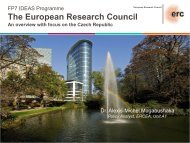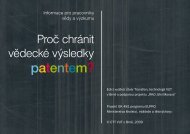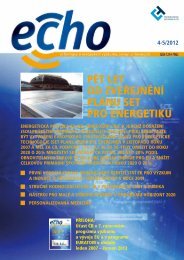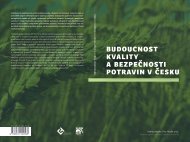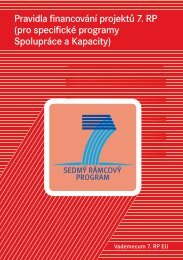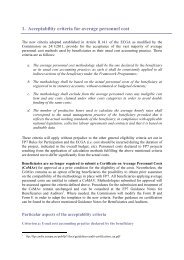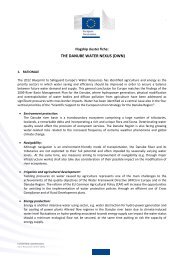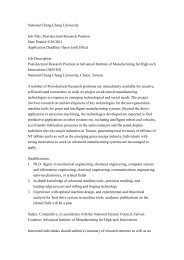Guide to Research and Innovation Strategies for Smart Specialisation
Guide to Research and Innovation Strategies for Smart Specialisation
Guide to Research and Innovation Strategies for Smart Specialisation
You also want an ePaper? Increase the reach of your titles
YUMPU automatically turns print PDFs into web optimized ePapers that Google loves.
have <strong>to</strong> spend 20% of their ERDF allocations on this <strong>to</strong>pic, <strong>and</strong> the less developed regions<br />
6%. Rural development policy has also rein<strong>for</strong>ced its contribution <strong>for</strong> the energy investments.<br />
Yet, achieving the EU's 20-20-20 objectives on greenhouse gas emissions, energy efficiency<br />
<strong>and</strong> renewables will require further innovations <strong>and</strong> a revolutionised energy system. In<br />
addition <strong>to</strong> this large scale roll-out of already established solutions, research <strong>and</strong> innovation<br />
will thus be critical <strong>to</strong> make new, cleaner, more efficient energy sources commercially<br />
attractive at the scale needed. The Strategic Energy Technology Plan (SET-Plan) 161 provides a<br />
long term agenda <strong>to</strong> address the key innovation bottlenecks. Thus, in assessing their position<br />
<strong>and</strong> assets in the context of the development <strong>and</strong> the subsequent implementation of their<br />
innovation strategies <strong>for</strong> smart specialisation, regions are invited <strong>to</strong> make full use of the<br />
knowledge developed in the framework of the SET-Plan.<br />
Eco-innovations<br />
The <strong>for</strong>thcoming EU Eco-<strong>Innovation</strong> Action Plan underscores that eco-innovations are central<br />
<strong>to</strong> addressing the challenges of resource scarcity, air, water <strong>and</strong> soil pollution or water<br />
efficiency. Eco-innovations also create major opportunities <strong>for</strong> growth <strong>and</strong> jobs <strong>and</strong> increase<br />
European competitiveness within the global market, which is estimated <strong>to</strong> grow <strong>to</strong> a trillion €<br />
market after 2015 162 . Already 45% of companies have introduced some type of ecoinnovation.<br />
It has been estimated that around 4% of eco-innovations led <strong>to</strong> more than a 40%<br />
reduction of material use per unit of output 163 , highlighting the great future potential.<br />
They must be promoted not only through technologies, but also through business processes<br />
<strong>and</strong> organisational change. In particular a closed-loop economy that aims <strong>to</strong> reduce, in<br />
absolute terms, inputs, waste <strong>and</strong> the release of harmful substances along the value chain <strong>and</strong><br />
foster re-use, recycling <strong>and</strong> resource substitution should be further rein<strong>for</strong>ced.<br />
This needs new business models, industrial symbiosis, product service systems, product<br />
design, full life cycle <strong>and</strong> cradle-<strong>to</strong>-cradle approaches. Managing authorities are encouraged<br />
<strong>to</strong> put eco-innovations at the core of their innovation strategies as a cross-cutting requirement<br />
in all sec<strong>to</strong>rs, liaising with the area specific stakeholders in the field of energy, water <strong>and</strong><br />
other natural resource management. The aim is <strong>to</strong> embed eco-innovations from the outset in<br />
the design <strong>and</strong> development of the strategies <strong>and</strong> programmes <strong>for</strong> innovation <strong>and</strong> tap in<strong>to</strong> its<br />
opportunities.<br />
Nature<br />
Eventually, the challenges regions face in terms of adaptation <strong>to</strong> climate change <strong>and</strong> the<br />
preservation <strong>and</strong> management of their natural assets ask <strong>for</strong> innovative approaches <strong>for</strong> regions<br />
<strong>to</strong> fully benefit from the underlying opportunities. Nature <strong>and</strong> its resources need <strong>to</strong> be fully<br />
integrated in the regional approaches <strong>to</strong> sustainable growth <strong>and</strong> the national/regional<br />
innovation strategies <strong>for</strong> smart specialisation.<br />
161 http://ec.europa.eu/energy/technology/set_plan/set_plan_en.htm<br />
162 European Parliament 'Policy Department Economic <strong>and</strong> Scientific Policy, Eco-innovation - putting the EU on<br />
the path <strong>to</strong> a resource <strong>and</strong> energy efficient economy, Study <strong>and</strong> briefing notes', March 2009.<br />
163Eco-innovation Observa<strong>to</strong>ry 'The Eco-<strong>Innovation</strong> Challenge - Pathways <strong>to</strong> a resource-efficient Europe -<br />
Annual Report 2010', May 2011.<br />
106



